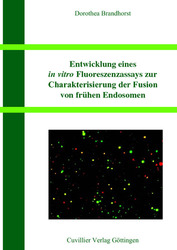| Departments | |
|---|---|
| Book Series (96) |
1378
|
| Nachhaltigkeit |
3
|
| Gesundheitswesen |
1
|
| Humanities |
2363
|
| Natural Sciences |
5406
|
| Mathematics | 229 |
| Informatics | 319 |
| Physics | 980 |
| Chemistry | 1363 |
| Geosciences | 131 |
| Human medicine | 243 |
| Stomatology | 10 |
| Veterinary medicine | 108 |
| Pharmacy | 147 |
| Biology | 835 |
| Biochemistry, molecular biology, gene technology | 121 |
| Biophysics | 25 |
| Domestic and nutritional science | 45 |
| Agricultural science | 1004 |
| Forest science | 201 |
| Horticultural science | 20 |
| Environmental research, ecology and landscape conservation | 148 |
| Engineering |
1791
|
| Common |
98
|
|
Leitlinien Unfallchirurgie
5. Auflage bestellen |
|
Advanced Search
Entwicklung eines in vitro Fluoreszenzassays zur Charakterisierung der Fusion von frühen Endosomen (English shop)
Dorothea Brandhorst (Author)Preview
Table of Contents, Datei (13 KB)
Extract, Datei (73 KB)
Im Rahmen dieser Arbeit wurde ein neuer in vitro Fluoreszenzassay zur Messung der Fusion von frühen Endosomen aus PC12-Zellen entwickelt und charakterisiert. Die Markierung der
frühen Endosomen in den Zellen erfolgte durch eine Fluid phase-Internalisierung der Fluoreszenzfarbstoffe Alexa 488 und Alexa 594, die an Dextrane gekoppelt waren. Nach Homogenisierung der Zellen wurden endosomenhaltige subzelluläre Fraktionen generiert, die mit Rattenhirnzytosol und ATP-regenerierendem System bei 37°C inkubiert wurden. Die Fusionsraten wurden durch Abstandsanalyse zwischen den unterschiedlich markierten Objekten in den mikroskopischen Bildern ermittelt. Die Fusion war abhängig von ATP, Temperatur, Calcium und Zytosol und erreichte nach ca. 45 min Inkubation ihren Maximalwert. Im Gegensatz zur Vakuolenfusion in S. cerevisiae konnte zu keinem Zeitpunkt der Fusionsreaktion von frühen Endosomen eine Resistenz gegen Verdünnung festgestellt werden.
The aim of this work was the development and characterization of a new in vitro fusion assay to measure early endosome fusion. Early endosomes from PC12 cells were labelled by fluid phase uptake with two different fluorescent dyes, Alexa 488 and Alexa 594, coupled to dextrans. After homogenization of the cells, endosome containing subcellular fractions were generated and combined with rat brain cytosol and an ATP regenerating system at 37 °C. Fusion rates were determined by measuring distances between the intensity centers of differently labelled objects. Fusion was dependent on ATP, temperature, calcium and cytosol and reached its maximum after 45 min of incubation. In contrast to yeast vacuoles no dilution resistance of early endosomes could be detected during the fusion reaction.
| ISBN-13 (Printausgabe) | 3865374263 |
| ISBN-13 (Hard Copy) | 9783865374264 |
| ISBN-13 (eBook) | 9783736914261 |
| Language | German |
| Page Number | 136 |
| Edition | 1 |
| Volume | 0 |
| Publication Place | Göttingen |
| Place of Dissertation | Göttingen |
| Publication Date | 2005-04-15 |
| General Categorization | Dissertation |
| Departments |
Biology
|








